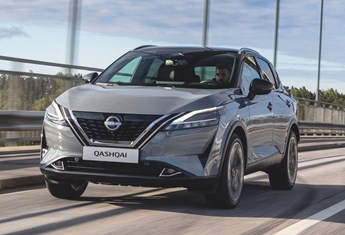We use cookies to ensure that we give you the best experience on our website. If you continue without changing your settings, we will assume that you are happy to receive all cookies on the Business Car website. However, if you would like to, you can change your cookies at any time

The start point for the best source of fleet information |
Model update: Nissan Qashqai E-Power
Date: 26 August 2022 | Author: Pete Tullin

|
|
||||||
ith so much critical acclaim and unbridled sales success under its belt, even Nissan's stingiest bean counters must struggle to argue a case against any upgrades the Qashqai development team deem appropriate.
This will be patently evident to anyone who has driven the excellent third-generation Qashqai, which received a total nuts and bolts revision at the beginning of 2021.
Even so, we can only imagine the showers of coffee that spurted across those shiny finance desks when the Qashqai's engineers suggested they needed a bespoke three-cylinder engine for a e-POWER variant.
This request must have seemed all the more incredulous when you consider this particular powertrain doesn't even use an engine as its primary driving force. Instead, the engine drives a generator, which sends power to a battery, then on to an electric motor, which is tasked with driving the front wheels.
Okay, so the absence of a gearbox probably went some way to cooling those whirring calculators, but a more obvious and much more cost-effective solution would have been to simply bolt in any of the many lumps Nissan already has in production and Robert would have been your Father's brother. Instead, Nissan engineers decreed that the engine they needed not only had to be super-efficient but also had to be the most refined three-cylinder motor ever to see the light of day.
Anyone familiar with three-cylinder engines will know just how unruly they can get and how far they can depart from their official WLTP figures when driven with any kind of forcefulness. This is certainly not the case with Nissan's engine. In truth, it's not a totally new engine, as it is in essence, a chopped-down version of the variable compression 2.0-litre four-cylinder engine found in some of Nissan's Infiniti luxury cars. Not wanting to bore you too much with the science, it essentially uses a variable crankshaft, meaning the compression ratio can be continuously adjusted so as to avoid high-pressure build-ups and minimise unwanted knockings and bangings. In practice, so little audible
noise or vibrations can be sensed, we'd challenge anyone to identify the engine's three-cylinder configuration.
Nissan hasn't stopped there in its pursuit of NVH Nirvana though, as a form of synthetic sound track management is piped into the cabin to further enhance the impression of combustion refinement.
Although the initial take-up isn't delivered with the same instantaneous response from rest as a fully electric vehicle, the E-Power Qashqai is far from a laggard and continues to build power in a linear fashion with enough forcefulness you rarely need to become overly aggressive with the accelerator pedal. Best of all that acceleration feels far more natural and connected than the rev-slurring antics you get from hybrids which use constantly variable transmissions.
The e-POWER is also able to help hone your driving skills, thanks to the one-pedal driving aspects of the selectable e-pedal, which was first introduced in the Leaf EV. Creating strong levels of regenerative deceleration simply by backing off the accelerator pedal, it's a labour-saving device that can be particularly edifying if you finesse your technique sufficiently to use it in stop-start traffic conditions.
As for related driving elements, the E-Power retains the Qashqai's inherent fine blend of comfort and control, making it an extremely easy and engaging car, with equal billing going to its light controls, neat and tidy handling and smoothly controlled ride quality.
The scale of the Qashqai's success also means there was plenty left in the cookie jar to spend on interior appointments. As a result, high-quality fixtures and fittings are used throughout the length and breadth of the cabin, giving an overall impression of excellent build integrity. While the interior is also inherently airy and spacious, providing plenty of room for four adults to travel in comfort, because the powertrain is smartly packaged, the boot area remains a very usable size.
As smooth and as fascinating as the E-Power tech undoubtedly is, unfortunately, its CO2 outputs are still way above those of plug-in alternatives, some of which aren't that much more expensive. With the knock-on effect to BIK implications, it's perhaps not surprising that Nissan concedes the E-Power Qashqai may be a short-lived stepping stone before the eventual arrival of its fully electric line-up.
Nissan Qashqai Tekna E-Power
P11D: £37,905
Residual value: 40.80%
Depreciation: £22,438
Fuel: £9,441
Service, maintenance and repair: £2,179
Cost per mile: 56.76p
Fuel consumption: 53.3mpg
CO2 (BIK %): 122g/km (29%)
BIK 20/40% a month: £183/£366
Luggage capacity: 504 litres
Engine size/power: 1,498cc + electric motor/190hp
Verdict |
8/10 |
|||
 |
|
 |
|
|











